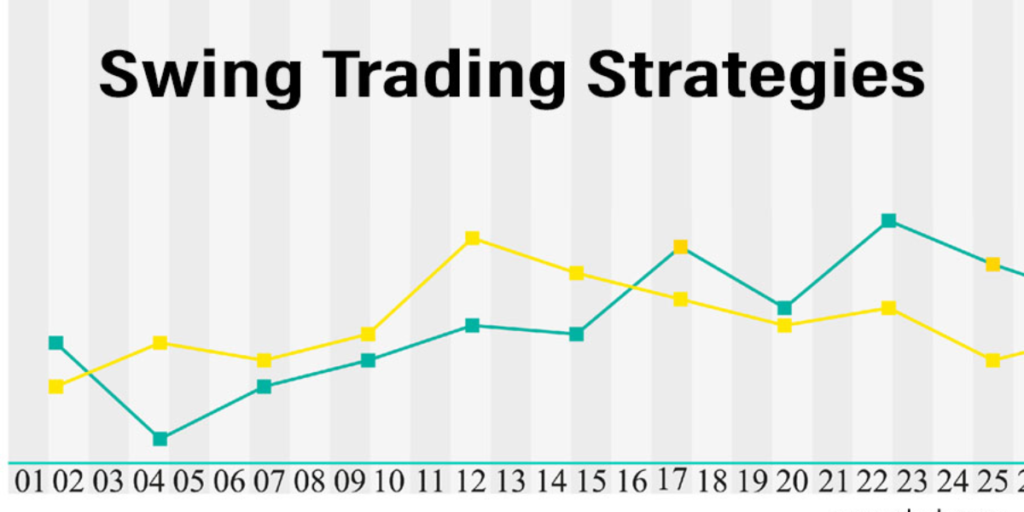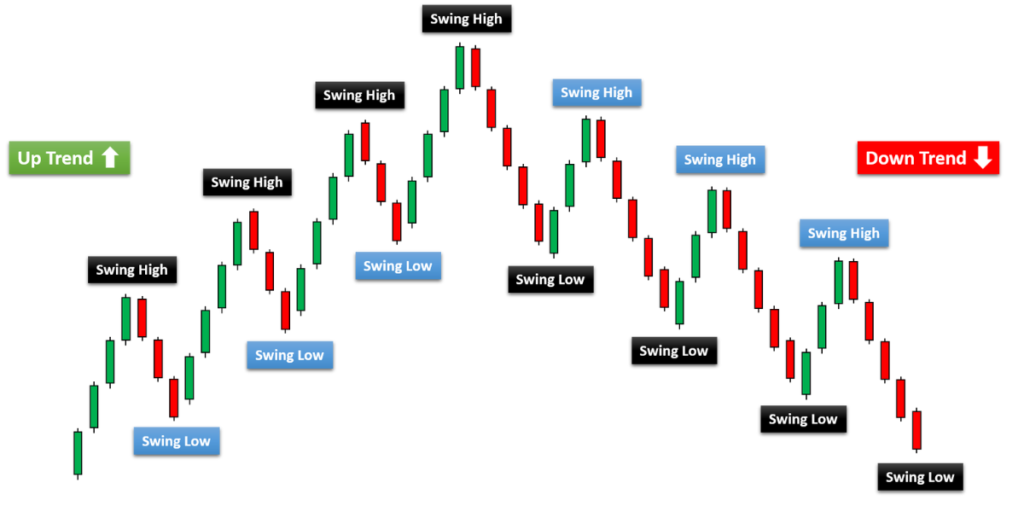Swing trading is a dynamic and exciting approach to the stock market that involves the capture of short- to medium-term gains in a security or any financial instrument over some days to a few weeks. It lies somewhere between day trading and long-term investing, providing the perfect blend between rapid action and thoughtful analysis. In this article, we’ll introduce you to what swing trading is, outline key strategies, and highlight stocks that come into view as ideal for this type of trading.
Table of Contents
1. What is Swing Trading?
Swing trading involves holding a security for an extended period, more than one day, but less than some months. Making money off of the “swings” in the security’s price is the primary goal. As opposed to the positioning of day traders, who close out all their positions before the close of every trading day, swing traders hold onto their trades for several days, weeks, or even months in order to reap gains from foreseen movements in prices.
This trading style is characterized by a great reliance on technical analysis. The swing traders look into the previous price movements and trading volumes of securities to make a prediction of the future price behavior. They also monitor market sentiments alongside news events that can move stock prices. While any financial instrument, such as currencies and commodities, may be traded in this style, swing trading is mostly associated with stocks.
2. Swing Trading Strategies

Swing trading requires some good strategy to be successful. Here are some common strategies which many swing traders follow:
A. Trend Following
Trend following is one of the simplest swing trading strategies. It essentially means to recognize a strong up or down trend in a stock and board the trend until it breaks the trend. That is, “Follow the trend until it ends.”
How to do it: Look for stocks that have established a clear trend. Use technical indicators like moving averages to confirm the trend. Enter the trade when the stock price pulls back to the moving average in an uptrend or rallies to the moving average in a downtrend.
B. Breakout Trading
Basically, breakout trading involves entering a trade when the price of a stock breaks any significant level of support or resistance. If the breakout occurs above the resistance, then it may be a signal for an upward move; and in case of a breakout below support, it may signal a downward move.
How to do it: Identify key support and resistance levels on the chart of the stock. Confirm the breakout using the volume indicators. When the price of the stock has broken through these levels on increased volume, that is when you enter the trade.
C. Reversal Trading
Reversal trading involves identifying areas where the price of a stock may reverse in trend. Swing traders identify signs an uptrend is likely to reverse into a downtrend or vice versa.
How to do it: Keep looking for reversal patterns like head and shoulders, double tops, or double bottoms. An example of an oscillator one may use to identify an overbought or oversold condition is the Relative Strength Index. Enter the trade upon witnessing these reversal patterns and signals.
Read More :- Stock Trading 101: A Step-by-Step Introduction, Intraday Trading: Effective Techniques for Success
D. Range Trading
Range trading represents activity involving the identification of stocks trading within a predefined price range, buying at the lower end, and selling at the upper end.
How to do it: Identify the range in which the stock is trading. When the price of the stock comes near the support, enter the trade and sell when the price comes near the resistance. Confirm the strength of the range using volume and momentum indicators.
E. Moving Average Crossovers
This will be useful in pointing out probable entry and exit points through moving averages. One of the common ways of doing this involves applying two moving averages—a shorter and a longer one.
How to do it: Sell the security when the short moving average crosses below the long moving average, for it may indicate a possible downtrend. Enter the trade at the time when the short moving average crossed over the long moving average, as this could indicate a possible uptrend.
3. Stock Selection for Swing Trading
Not all stocks are suitable for swing trading. Here are some characteristics of the kind of stocks you should be looking for:
A. Liquidity : Pick stocks that have a high trading volume. It is simpler to acquire and sell liquid stocks, and manipulating their price is more difficult.
B. Volatility : Look for equities with a range of volatility from moderate to high. These kinds of stocks usually have bigger price swings, which offer more opportunities for profit.
C. Trend : Prefer those stocks that are trending, either upwards or downwards. Stocks that are not showing any trend can be difficult to trade since they do not give an obvious entry and exit signals.
D. Fundamentals : Even if swing trading does rely on technical analysis, it is impossible to totally ignore the fundamentals of the stock. Shun those with bad earnings reports or other bad news, for such events may send prices moving in unpredictable ways.
4. Examples of Swing Trading Stocks

The following are some examples of stocks that are found to be good candidates for swing trading:
A. Apple Inc. (AAPL) : Apple is one of the most liquid stocks available in the market, and it has high daily trading volumes. The swings and trends in its stock price are pretty regular and clear, making it a favorite for many swing traders.
B. Tesla Inc. (TSLA) : Tesla is an extremely volatile company, subject to extreme price swings. As the stock is usually trending strongly, there are good opportunities for the swing trader to join the move and ride the trend.
C. Amazon.com Inc. (AMZN) : The second highly liquid stock with big trading volumes is Amazon. It, too, can trend very strongly, making it quite suitable for swing trading.
D. Advanced Micro Devices Inc. (AMD) : AMD is considered one of the swing trader favorites because of the reasons it comes with moderate to high volatility, and price trends are very clear. Other than these things, it’s also a liquid stock, meaning that you don’t have any trouble getting in or out.
5. Getting Started with Swing Trading
A. Learn the Stuff First : Make sure to invest adequate time learning about the equity market, technical analysis, and various techniques associated with swing trading before you actually start swing trading. There are plenty of books, online courses, and tutorials that will get you up and running.
B. Choose a Reliable Broker : Choose a brokerage platform that will help you in the swing trading process with the proper tools and resources. The features such a platform should offer include low fees, charting advanced tools, and educational resources.
C. Create a Trading Plan : The trading plan states what your strategy is, including the conditions for entering and exiting a trade and the rules of risk management, along with your goals. It helps you stay disciplined and avoid emotional trading decisions.
D. Start Small : Always start with a small investment to minimize the risks involved. Once you feel confident and experienced, you can gradually increase the size of your investments.
E. Practice with Paper Trading : Most brokerage platforms offer what’s called a paper trading account. You can practice trading with virtual money. This will help you sharpen your skills without losing any real money.
F. Monitor Your Trades : Keep a tight vigil over trades and the market. Review your trading plan regularly to make any necessary changes in light of your performance and changing market conditions.
6. Common Problems in Swing Trading

Swing trading can be very rewarding, but it is also riddled with several challenges. Here are some common problems that swing traders face:
A. Market Volatility : The stock market can get really very unpredictable, and at times, the prices can just go haywire. Unless appropriately managed, volatility may result in huge losses.
B. Emotional Trading : It is easy to get swayed by emotions like fear and greed into making a trading decision. It is essential that you stick with your trading plan and maintain the necessary discipline to avoid emotional trading.
C. Overtrading : Increased transaction costs due to excessive trading enhance the risk. Focus more on the quality of trades in very strong setups rather than frequent trading.
D. False Signals : Technical analysis is not perfect, and sometimes the signal could be false which may result in losses. The usage of multiple indicators and confirmation signals reduces the occurrence of false signals.
Conclusion
Swing trading offers a balanced approach between the fast pace of day trading and the long-term commitment of investing. By holding positions for a few days to weeks, swing traders can take advantage of intermediate-term price movements and trends. Success in swing trading requires a solid understanding of technical analysis, a well-defined trading plan, and effective risk management techniques. As a beginner, take the time to educate yourself, practice with paper trading, and start small to build your confidence and skills.
Remember, swing trading is not a get-rich-quick scheme. It requires patience, discipline, and continuous learning to navigate the complexities of the stock market. Whether you’re looking to supplement your income or pursue trading full-time, swing trading can be a rewarding strategy if approached with the right mindset and preparation. Happy trading!
